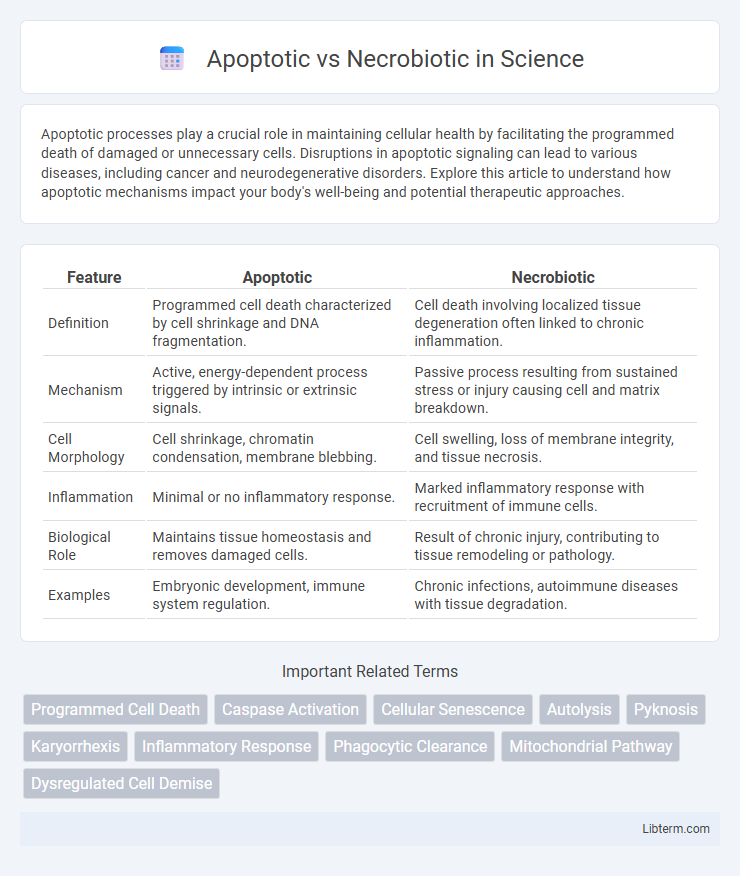Apoptotic processes play a crucial role in maintaining cellular health by facilitating the programmed death of damaged or unnecessary cells. Disruptions in apoptotic signaling can lead to various diseases, including cancer and neurodegenerative disorders. Explore this article to understand how apoptotic mechanisms impact your body's well-being and potential therapeutic approaches.
Table of Comparison
| Feature | Apoptotic | Necrobiotic |
|---|---|---|
| Definition | Programmed cell death characterized by cell shrinkage and DNA fragmentation. | Cell death involving localized tissue degeneration often linked to chronic inflammation. |
| Mechanism | Active, energy-dependent process triggered by intrinsic or extrinsic signals. | Passive process resulting from sustained stress or injury causing cell and matrix breakdown. |
| Cell Morphology | Cell shrinkage, chromatin condensation, membrane blebbing. | Cell swelling, loss of membrane integrity, and tissue necrosis. |
| Inflammation | Minimal or no inflammatory response. | Marked inflammatory response with recruitment of immune cells. |
| Biological Role | Maintains tissue homeostasis and removes damaged cells. | Result of chronic injury, contributing to tissue remodeling or pathology. |
| Examples | Embryonic development, immune system regulation. | Chronic infections, autoimmune diseases with tissue degradation. |
Introduction to Cell Death Mechanisms
Apoptotic cell death is a regulated, energy-dependent process characterized by cell shrinkage, chromatin condensation, and membrane blebbing, facilitating clean removal without inflammation. Necrobiotic cell death, often a form of necrosis, involves loss of membrane integrity, swelling, and uncontrolled release of cellular contents, triggering inflammatory responses. Understanding these distinct mechanisms is crucial for elucidating cellular responses in development, disease, and therapeutic interventions.
Defining Apoptosis: Programmed Cell Death
Apoptosis is a form of programmed cell death characterized by controlled cellular dismantling, DNA fragmentation, and membrane blebbing, crucial for maintaining tissue homeostasis and development. Unlike necrobiotic processes that involve uncontrolled cell death leading to inflammation and tissue damage, apoptosis proceeds without eliciting an immune response. Key molecular pathways invoking caspase activation and mitochondrial cytochrome c release define apoptosis as a tightly regulated biological mechanism.
Understanding Necrobiosis: Natural Cell Replacement
Necrobiosis is a natural physiological process where cells undergo degeneration and are gradually replaced, maintaining tissue homeostasis without triggering inflammation. In contrast, apoptosis is a programmed cell death mechanism characterized by controlled cellular dismantling and phagocytosis, preventing immune responses. Understanding necrobiosis highlights its crucial role in continuous cell turnover, especially in connective tissues like skin and cartilage, supporting organismal renewal and repair.
Morphological Differences: Apoptosis vs Necrobiosis
Apoptosis is characterized by cell shrinkage, chromatin condensation, and formation of apoptotic bodies with intact plasma membranes, facilitating phagocytosis without inflammation. Necrobiosis involves progressive cytoplasmic swelling, loss of membrane integrity, and nuclear fragmentation, often resulting in inflammation and tissue damage. Morphologically, apoptosis exhibits an organized, energy-dependent breakdown, whereas necrobiosis reflects uncontrolled cell degeneration and necrosis.
Biochemical Pathways Involved
Apoptotic pathways primarily involve caspase activation, mitochondrial cytochrome c release, and Bcl-2 family protein regulation, leading to programmed cell death with membrane blebbing and DNA fragmentation. In contrast, necrobiotic processes are characterized by uncontrolled cell lysis, often triggered by external factors causing ATP depletion, loss of ion homeostasis, and activation of proteolytic enzymes such as calpains and cathepsins. The distinct biochemical cascades highlight apoptosis as an energy-dependent, tightly regulated mechanism, whereas necrobiosis results from metabolic failure and cellular injury inducing inflammation.
Physiological Roles in Health and Disease
Apoptotic processes maintain cellular homeostasis by enabling controlled cell death essential for tissue remodeling, immune system function, and removal of damaged or potentially harmful cells, preventing chronic inflammation and tumorigenesis. Necrobiotic mechanisms, characterized by pathological tissue degeneration and impaired cell clearance, contribute to chronic inflammatory diseases, autoimmune disorders, and neurodegeneration due to the release of intracellular contents provoking immune responses. Understanding the balance between apoptosis and necrobiosis is critical for developing therapeutic strategies targeting cancer, inflammatory diseases, and tissue repair.
Detection and Assessment Techniques
Apoptotic cell death is commonly detected using techniques such as flow cytometry with Annexin V staining, TUNEL assay for DNA fragmentation, and caspase activity assays, which specifically indicate programmed cell death. Necrobiotic processes, characterized by extensive cellular degeneration and associated with inflammation, are often assessed through histological staining methods like H&E, alongside biomarkers of oxidative stress and membrane integrity assays. Advanced imaging modalities, including electron microscopy, provide crucial morphological differentiation between apoptosis and necrobiotic cell death.
Clinical Significance of Apoptosis and Necrobiosis
Apoptosis plays a crucial role in maintaining tissue homeostasis by eliminating damaged or unwanted cells without triggering inflammation, essential in preventing cancer and autoimmune diseases. Necrobiosis, often noted in dermatopathology, signifies degenerative changes leading to cell death associated with chronic inflammation, commonly observed in conditions like granuloma annulare and necrobiosis lipoidica. Understanding the distinction aids clinicians in diagnosing and managing inflammatory and degenerative diseases by targeting specific pathways involved in programmed cell death versus cell degeneration.
Implications for Therapeutic Interventions
Apoptotic cell death involves programmed, regulated processes that minimize inflammation, making it a key target for therapies aimed at promoting tissue homeostasis and reducing autoimmune responses. Necrobiotic cell death, characterized by uncontrolled cellular disintegration and inflammation, is linked to increased tissue damage and chronic diseases, thus therapies targeting necrobiotic pathways focus on inhibiting inflammatory cascades and mitigating secondary damage. Understanding the molecular differences between apoptotic and necrobiotic mechanisms informs the development of selective drugs that either enhance apoptotic clearance or suppress necrobiotic injury to improve clinical outcomes in degenerative and inflammatory conditions.
Summary and Future Perspectives
Apoptotic processes involve programmed cell death characterized by cell shrinkage, chromatin condensation, and DNA fragmentation, maintaining tissue homeostasis without inflammatory response, while necrobiotic changes typically represent degenerative cell death associated with inflammation and tissue damage. Future research aims to elucidate molecular pathways distinguishing apoptosis from necrobiosis, enhancing targeted therapies for diseases such as cancer and neurodegeneration. Advancements in biomarkers and imaging techniques promise improved diagnostic precision and therapeutic interventions modulating these cell death mechanisms.
Apoptotic Infographic

 libterm.com
libterm.com